AEVITA : designing biomimetic vehicle-to-pedestrian communication protocols for autonomously operating & parking on-road electric vehicles
Author(s)
Pennycooke, Nicholas (Nicholas D.)
DownloadFull printable version (28.99Mb)
Alternative title
Designing biomimetic vehicle-to-pedestrian communication protocols for autonomously operating & parking on-road electric vehicles
Other Contributors
Massachusetts Institute of Technology. Dept. of Architecture. Program in Media Arts and Sciences.
Advisor
Kent Larson.
Terms of use
Metadata
Show full item recordAbstract
With research institutions from various private, government and academic sectors performing research into autonomous vehicle deployment strategies, the way we think about vehicles must adapt. But what happens when the driver, the main conduit of information transaction between the vehicle and its surroundings, is removed? The EVITA system aims to fill this communication void by giving the autonomous vehicle the means to sense others around it, and react to various stimuli in as intuitive ways as possible by taking design cues from the living world. The system is comprised of various types of sensors (computer vision, UWB beacon tracking, sonar) and actuators (light, sound, mechanical) in order to express recognition of others, announcement of intentions, and portraying the vehicle's general state. All systems are built on the 2 nd version of the 1/2 -scale CityCar concept vehicle, featuring advanced mixed-materials (CFRP + Aluminum) and a significantly more modularized architecture.
Description
Thesis (S.M.)--Massachusetts Institute of Technology, School of Architecture and Planning, Program in Media Arts and Sciences, 2012. Cataloged from PDF version of thesis. Includes bibliographical references (p. 125-127).
Date issued
2012Department
Program in Media Arts and Sciences (Massachusetts Institute of Technology)Publisher
Massachusetts Institute of Technology
Keywords
Architecture. Program in Media Arts and Sciences.